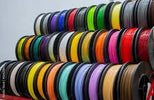
What Even Is 3D Printing? A Friendly Introduction to the Chaos and the Craft
2 min reading time

2 min reading time
So, what is 3D printing? Think of it like an overcomplicated glue gun with a slight attitude, demanding a proper sacrifice to the spaghetti gods.
Once upon a time, printers could only put ink on paper. Then someone had the wild idea: “What if a printer could make things instead of pictures?” And that’s pretty much how 3D printing began. Back in the 1980s, the first machines used lasers to solidify liquid plastic into thin layers, creating small prototypes for engineers to test before mass production. It was slow, expensive, and definitely not something you could fit on your desk.
Fast forward a few decades, and 3D printing has become far more accessible. Today, you’ll find printers tucked into homes, schools, and workshops around the world, turning imagination into something you can actually hold. It’s used to make toys, art, tools, custom parts, and even medical devices. What once required a massive budget and a lab now only needs a curious mind and a roll of filament.
So, what is 3D printing? Imagine a robotic glue gun that builds objects one layer at a time. It melts thin strands of plastic, carefully drawing each layer until a shape slowly appears. The printer follows a digital blueprint called an STL file, which tells it exactly where to move and how much material to use. Over time, the layers stack together so smoothly that they become a solid object, kind of like a cake that frosts itself, except this one occasionally throws a tantrum if the stars (or settings) aren’t aligned. In other words, it’s an overcomplicated glue gun with a slight attitude if a proper sacrifice to the spaghetti gods wasn’t performed first.
There are a few different kinds of 3D printing, but the most common for hobbyists is called FDM (Fused Deposition Modeling). It’s the one that works with rolls of filament, feeding them through a heated nozzle to create each layer. Other types like resin printing, use light instead of heat, curing liquid resin into ultra-detailed miniatures and parts. Each method has its strengths: filament printing is great for colorful, durable pieces, while resin printing shines when detail really matters.
The beauty of 3D printing is how flexible it is. You can design a part from scratch, download a model online, or tweak something existing to make it your own. Need a replacement clip for a broken tool? You can print one. Want to create a tiny dragon or a life-size helmet? That’s on the menu too. It’s part art, part science, and part trial-and-error—which is half the fun.
If this sparked your curiosity, you’re in the right place. In upcoming posts, I’ll walk through the design process, the different types of filament (and why they matter), and how 3D printing is being used in the world today—from classrooms to custom art studios. So grab a coffee, stay curious, and let’s keep exploring how imagination becomes reality—one layer at a time.